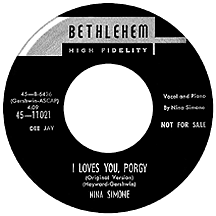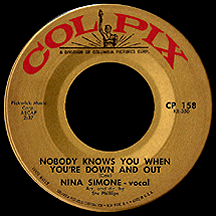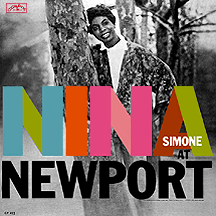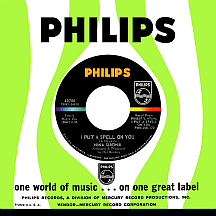NINA SIMONE
After some ups and downs, Nina Simone was ready to take on the music world in 1958, at 25 a mature singer and classically-trained pianist with a contempt for pop music, yet a willingness to perform it. The 1935 Broadway production of Porgy and Bess, based on a book by Heyward DuBois with music and lyrics by George and Ira Gershwin, had demonstrated staying power. The stage play, ultimately accepted as a classic American folk opera, had already been revived a few times by 1959, the year it was made into a film starring Sidney Poitier and Dorothy Dandridge. Simone's recording of "I Loves You, Porgy," taken from her 1958 debut album Little Girl Blue, was released as a single around the time of the movie's theatrical run and became her only major hit (in the U.S. at least), making it to the top 20 on the pop charts and number two rhythm and blues. Yet rather than being her lone "one-hit wonder" moment, it served as an introduction to mainstream music fans. Nina's fascinating career was just getting started.
Born Eunice Kathleen Waymon in the small town of Tryon, North Carolina, she was drawn to the piano as a child and began practicing as soon as she was big enough to reach the keys, later playing in church and receiving help from local citizens to fund her lessons. Becoming a classical pianist was Eunice's single-minded goal, but she soon realized that compromise would be necessary if she were to have any kind of a career in music. After high school she auditioned for a scholarship to Philadelphia's Curtis Institute of Music but failed to make the cut. There's a strong possibility that her color was the reason for the rejection, and she made a point of telling that to people, continuing to bring up the subject for many years. Despite the setback, her obvious talent and drive got her into New York's Juilliard School of Music shortly afterward.
Around 1954, while working as a performer at a club in Atlantic City to pay for her schooling, Eunice was informed that it wasn't enough just to play piano; she would have to sing if she wanted to keep her job. The added chore, she discovered, wasn't such a bad thing. Her voice, in fact, had a deepness and resonance that was quite unique, and patrons of the bar reacted favorably. She began billing herself as Nina Simone (after the Spanish word "niña," meaning "young girl," and the first name of acclaimed actress Simone Signoret). After a few years of continued schooling (hanging on to the dream of a career in classical music) and appearing in small clubs (the sometimes disconcerting reality), she received an offer from the Bethlehem label, a subsidiary of Syd Nathan's King Records.
Her first recordings in 1958 and subsequent '59 hit "Porgy" set things rolling, the classical goal becoming less and less of an option. It was a good thing for music fans that it happened that way...as much as she had shunned a pop music career, the infusion of jazz, blues and the gospel music she was raised on, in addition to African rhythms and assorted other global influences, resulted in her evolution as an artist unlike any other. Some excellent songs came out of her time at Bethlehem, including "My Baby Just Cares For Me" (written by Walter Donaldson and Gus Kahn in 1930), which would become a career highlight many years later. She also recorded a series of instrumentals, mostly jazz-style tracks focusing on her piano playing, a rare thing for your typical female vocalist, but a logical approach considering her childhood passion. "African Mailman" is an outstanding early example.
Simone left Bethlehem in 1959 and signed a deal with Colpix Records that gave her more creative freedom. Many releases were live concert recordings, and her choices in the studio showed a flexibility, as she was well aware of the commercial value of an occasional pop single. "Nobody Knows You When You're Down and Out," written by Jimmy Cox in 1923 and a hit for Bessie Smith in '29, was given the Simone treatment with a slick arrangement by Stu Phillips and put her back on the pop and R&B charts in September 1960. Though she was writing songs during this time, Nina drew from 1920s-era jazz and blues for a great deal of her material; the 1926 blues standard "Trouble in Mind" (written by pianist Richard M. Jones), a live track from the best-selling album Nina at Newport, again put her on both singles charts in January 1961. That same year she married Andrew Stroud, a New York City police detective. Committing himself to raising her profile in the world of music, Stroud later quit the force to manage her career. Nina was more concerned about expressing herself as an artist than of the commercial aspects of the business; political discontent would soon be a dominant theme in her music.
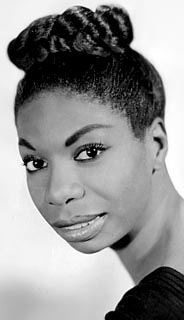
Simone switched labels again, signing with Dutch-owned Philips (as well as the U.S. Philips label) in 1964. Her anger concerning the June 1963 murder of civil rights activist Medger Evers in addition to other atrocities including the bombing of a Baptist church in Birmingham, Alabama three months later, which took the lives of four young girls, came out in a song. "Mississippi Goddam" was recorded in 1964 and released on her first album for the new label, Nina Simone in Concert. Her performance, set to an unusually light, bouncy rhythm, and the attending audience's reaction, comes off as a bit humorous, but the lyrics are filled with biting protest: 'Alabama's got me so upset, Tennessee made me lose my rest...and everybody knows about Mississippi...' She made her position clear with the song's line 'You don't have to live next to me, just give me my equality' (on singles the title was shown as "Mississippi *%??**&%," or in some cases simply "Mississippi," and the offending word was, not surprisingly, bleeped...not that it made much difference, as few stations dared risk the FCC's wrath by playing it). From that point on, many of Nina's songs took a more active stand toward a number of political issues, the Civil Rights movement foremost among them. As her manager, Stroud preferred otherwise, but Nina would not be swayed.
The mid-'60s tenure with Philips and revised musical direction brought an upswing in album sales. Single record highlights at that time include "Don't Let Me Be Misunderstood," written by Bennie Benjamin, Sol Marcus and Gloria Caldwell, who contributed several compositions to her Philips label repertoire; a very different version by The Animals was a much bigger hit in early 1965 than Simone's '64 original. One of the earliest to tackle the notorious Screamin' Jay Hawkins classic "I Put a Spell on You," she gave the much-recorded 1956 song her own brand of ominous in '65.
A move to RCA Victor in 1967 led to one of the most successful periods of Simone's career. Her interpretation of Morris Bailey, Jr.'s "(You'll) Go to Hell" put forth a make-no-bones-about-it point of view about people's religious beliefs (or lack thereof): 'If your mind lies in the devil's workshop, and evil doin's your thrill...and trouble and mischief is all you live for, you know darn well...you'll go to hell.' Potential controversy didn't concern Nina Simone; she never hesitated to convey what she was feeling through her music. She received her first of two Grammy nominations for the song but never won the award, an astounding oversight. At times her pain was on display for all to see, perhaps never more so than during a performance at the Westbury, New York Music Fair on April 7, 1968 (three days after the assassination of Reverend Martin Luther King, Jr.). "Why? (The King of Love is Dead)," written by Nina's bass player Calvin Taylor, has since been acknowledged as the first song to pay tribute to Dr. King following his death.
Songwriter Jimmy Webb was on a hot streak in the late '60s, penning hits for The 5th Dimension, Glen Campbell, Richard Harris and others. Simone's conventional rendition of Webb's "Do What You Gotta Do" put her back on the charts in the fall of 1968. Simultaneously, the song appeared in England (where she'd essentially been hitless) as the B side of her version of "Ain't Got No; I Got Life" from the trendsetting Broadway musical Hair. Suddenly and without warning it took Great Britain by storm, climbing to number two on the charts in December, a bigger hit there than anything she'd had back home. An unusual song with two titles, it wasn't a medley but rather one song in two parts, going from negative to positive: 'Ain't got no...home, shoes, money, class...culture, friends, schoolin', love...' followed by 'I've got my...eyes, nose, mouth, smile...I've got life...I've got my freedom!' In the U.S., RCA released the single as the follow-up to "Do What You Gotta Do." Though the musical had been running on Broadway since April '68, the success of Nina's recording (along with "Where Do You Go" by Carla Thomas) ran ahead of the curve; Hair went on to rule the charts in 1969 with several huge cover hits by a diversity of acts (the 5th Dimension, The Cowsills, Oliver and Three Dog Night) while the Original Cast recording held number one on the album charts for three months in the spring and summer, more than a year after the show's New York debut.
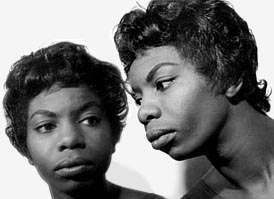
1969 was Simone's peak year, particularly considering her breakout popularity in Britain, further confirmed when a previous U.S. release became an "Ain't Got No" follow-up top ten hit that summer; "To Love Somebody" was actually much bigger in the U.K. than The Bee Gees' original had been in '67. America saw the release of another Civil Rights-related song, "To Be Young, Gifted and Black," written by Nina and Weldon Irvine, taking inspiration from the late playwright Lorraine Hansberry's autobiographical play of the same title. 'There's a world waiting for you...yours is the quest that's just begun' offered encouragement and hope to aspiring African-Americans...and anyone else able to see beyond the song's specificity. It made the biggest impact of her late-'60s output, putting her into the top ten on the R&B charts for the first time since "I Loves You, Porgy" ten years earlier.
The 1970s found Nina heading in a different direction. She left the United States, admitting later that her frustration with the Civil Rights struggle culminating in Dr. King's assassination had a lot to do with it. She lived in several countries over the years including Barbados, Liberia, Switzerland, France and England, with occasional extended visits to the U.S., yet she did very little recording or performing during those years. An unexpected windfall came her way in 1987 when "My Baby Just Cares For Me," from that first session for Bethlehem in 1958, was used in a Chanel No. 5 TV commercial in Great Britain. A reissue of the record hit the U.K. top ten and she was in high demand in Europe from that point onward. She was more visible in the States, too, making many concert appearances until her death in 2003. Someone had nicknamed her the "High Priestess of Soul" back in the '60s, and it was even used as the title of a 1967 album on Philips. She wasn't fond of the bestowed title, yet it's been commonly used ever since. I'll accede to Nina on this one, but deep down I feel she deserves some sort of grand nickname. How about the all-encompassing "High Priestess of Music"? Sounds right to me!
NOTABLE SINGLES:
- My Baby Just Cares For Me - 1959
- I Loves You, Porgy - 1959
- Little Girl Blue /
He Needs Me - 1959 - Don't Smoke in Bed /
African Mailman - 1959 - Willow Weep For Me - 1959
- Nobody Knows You When You're Down and Out - 1960
- Trouble in Mind - 1960
- Gin House Blues - 1961
- I Want a Little Sugar in My Bowl - 1962
- Little Liza Jane - 1963
- Mississippi Goddam - 1964
- Don't Let Me Be Misunderstood - 1964
- I Put a Spell on You - 1965
- (You'll) Go to Hell - 1967
- To Love Somebody - 1968
- Do What You Gotta Do - 1968
- Ain't Got No; I Got Life - 1968
- Revolution - 1969
- To Be Young, Gifted and Black - 1969


